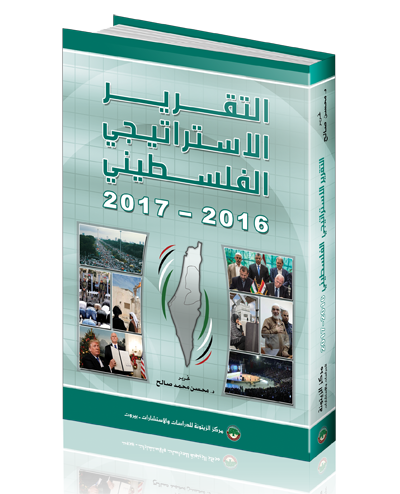Al-Zaytouna Centre for Studies and Consultations in Beirut is offering the Arabic version of the Palestine Strategic Report 2016–2017 (PSR) for free download. It discusses the Palestine issue during those years, offering a wealth of data, up-to-date statistics and analyses, in addition to an outlook of future events.
The 490-page PSR was edited by Dr. Mohsen Mohammad Saleh, written by 14 specialized researchers, and reviewed by four consultants. It consists of eight chapters, the most prominent projections for 2018–2019, and an index.
| >> Free Download: The Palestine Strategic Report 2016–2017 |
Publication Information Arabic – Title: Al-Taqrir al-Istratiji al-Filastini 2016-2017 (The Palestine Strategic Report 2016–2017 ). – Edited by: Dr. Mohsen Mohammad Saleh – Published in: 2018 – Hard Cover: 490 pages. – Price: $25 – ISBN: 978-9953-572-71-0 |
 |
The first chapter discusses the internal Palestinian scene, which includes Palestinian representative institutions, the national consensus government, developments related to putting the Palestinian political house in order and national reconciliation, and status of Palestinian factions. It also discusses the questions of freedoms and Palestinian-Israeli security coordination, and their implications on the internal Palestinian situation.
The second chapter displayed the Palestinian demographic and economic indicators, which include the Palestinian population worldwide, the demographic characteristics of Palestinians, the demographic growth trends, and Palestinians outside Palestine and the right of return. The chapter discussed also the economic indicators in the West Bank (WB) and the Gaza Strip (GS); Gross domestic product (GDP); GDP per capita, public debt and general budget; Employment, unemployment and poverty; Industrial and agricultural activities and trade; Foreign aid and its effects; in addition to the economic repercussions of the GS siege.
The third chapter is about the Land and the holy sites. It discusses the latest developments concerning Jerusalem, holy sites and settlement expansion, Israeli targeting of Islamic and Christian holy sites, the population in Jerusalem under occupation, Judaization and settlements, political developments concerning Jerusalem, Israeli settlement expansion in WB, and the Separation Wall and Barriers in WB.
The fourth chapter is about the aggression, resistance and the peace process. It discusses Israeli aggression and Palestinian resistance, Palestinian resistance inside Palestine, the Jerusalem Intifadah 2016–2017 and the Lion’s Gate uprising. It reports on the Israeli killed and wounded, the Palestinian killed and wounded in WB and GS, the suffering of Palestinian prisoners and detainees, and the Israeli GS siege. It also discusses the peace process, initiatives which followed the failure of Kerry’s plan, the Trump administration and “Deal of the Century,” in addition to the possible scenarios after the US decision.
Chapter five discusses the Israeli scene, including the most prominent Israeli political, demographic, economic and military developments. It explores how the left wing declined and the far right wing strengthened, the racist laws and political prosecutions, State Comptroller report on the Gaza War, the death of Shimon Peres and the repercussions of his funeral, increasing the “Jewishness of the State” at the expense of its democracy, and the moral scandals. It also discussed how Netanyahu and his government were investigated for corruption and bribery, the development of the settlement project domestically, and the Jerusalem Intifadah and its implications.
This chapter also explores the Israeli demographic indicators, such as the population of Israel, Jewish immigrants to Israel, world Jewish population, Israeli economic indicators such as Israeli GDP, GDP per Capita, trade, Israel exports and imports, and US aid to Israel. As for the Israeli military indicators, they include appointments and structural changes, manpower, military plans and directions, military maneuvers, arms and arms trade, and the military budget. At the end of the chapter, the Israeli position on the internal Palestinian situation is discussed, especially Palestinian reconciliation.
Chapter six discusses the Palestine issue and the Arab world. It explores positions of the League of Arab States concerning the Palestine issue and the schism, the position on the peace process, positions and roles of some key states, such as Egypt, Jordan, Syria, Lebanon, GCC countries, and others. It also discusses developments concerning political and economic normalization of some Arab countries with Israel.
As for chapter seven, it is about the Palestine issue and the Muslim world. It discusses the policy of the Organisation of Islamic Cooperation (OIC) and other Muslim countries towards the Palestine issue. The Turkish foreign policy variables are discussed, in addition to the Turkish political and economic relations with Israeli and Palestinian parties. Iran’s threat to Israel and its relations with Palestinian resistance factions are also discussed, in addition to the responsiveness of the Muslim public to the Palestine issue, and the normalization and Israeli relations with various Muslim Countries.
The eigth chapter, which is the last one, discusses the Palestine issue and the International scene. It studies the stances of the Quartet, UN and international organizations, in addition to positions of the US, EU, BRICS (Brazil, Russia, India, China and South Africa), Japan and other countries towards the Palestine issue.
The PSR is one of al-Zaytouna’s most important academic studies, published periodically in both English and Arabic. Today, it can be surely asserted that PSR is a must reference for every researcher and academic who are interested in the contemporary developments of the Palestinian issue and the Arab-Israeli conflict. The PSR reviews biennially the various developments concerning the Palestinian question in a comprehensive, objective and academic manner. It offers a wealth of data, up-to-date statistics, and analyzes and offers an outlook of future events.
| >> Free Download: The Palestine Strategic Report 2016–2017 |








Leave A Comment